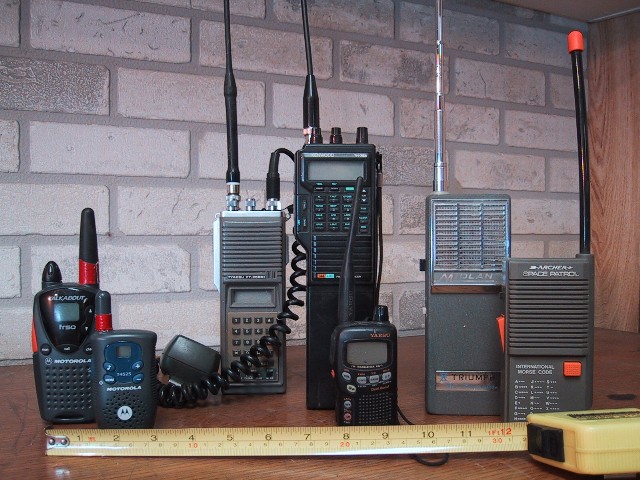Recreational_Walkie_Talkies.jpg
Summary
| Description Recreational Walkie Talkies.jpg |
English:
A collection of
walkie-talkies
, handheld portable
two-way radios
for recreational use. From left:
Commercial and emergency services walkie-talkies may be similar in size to the amateur units shown here, but generally have much better battery life, more rugged construction, and simpler controls, often restricting operation to only one or a few pre-programmed channels. In addition, many have ruggedizing features such as waterproofing (especially for outdoors and marine use) and intrinsically safe design for use in fire-prone industrial environments. The two older walkie-talkies on the right use only discrete transistors; all the more recent ones shown here use microprocessors and integrated circuits for most of their functions. |
| Date | 21 April 2005 (original upload date) |
| Source | Transferred from en.wikipedia to Commons by Premeditated Chaos using CommonsHelper . |
| Author | Wtshymanski at English Wikipedia |
Licensing
| Public domain Public domain false false |
|
|
This work has been released into the
public domain
by its author,
Wtshymanski
at
English Wikipedia
. This applies worldwide.
In some countries this may not be legally possible; if so: Wtshymanski grants anyone the right to use this work for any purpose , without any conditions, unless such conditions are required by law. Public domain Public domain false false |
Original upload log
The original description page was
here
. All following user names refer to en.wikipedia.
- 2005-04-21 04:01 Wtshymanski 640×480× (107183 bytes) {pd} Recreational walkie-talkies. From the left: two different models of [[FRS]] radios by Motorola. Third from the left an early 1980's [[amateur radio]] radio for the [[2 metre]] band, complete with external speaker-mike, and [[DTMF]] keypad for remote
Captions
Recreational, toy and amateur radio walkie-talkies

